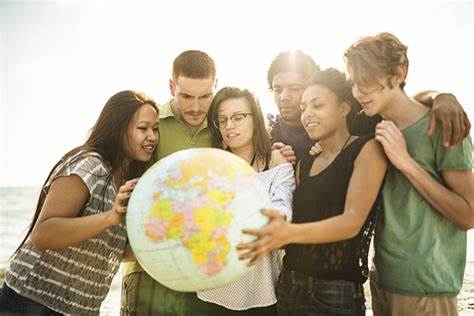Culture plays a pivotal role in shaping both personal and group identities. It encompasses the values, beliefs, norms, and practices that individuals and communities inherit and develop over time. This article explores how culture influences identity, examining its effects on individuals and groups, and highlighting the complex interplay between cultural heritage and modern identity formation.

The Role of Culture in Shaping Personal Identity
- Cultural Socialization: From a young age, individuals are socialized into their culture through family, education, and community. This process instills cultural norms and values, shaping an individual’s worldview and self-concept. For instance, in collectivist cultures, such as many Asian societies, individuals may develop a strong sense of belonging and interdependence, whereas in individualist cultures, like the United States, personal achievement and independence are often emphasized.
- Language and Communication: Language is a core component of culture and a crucial aspect of identity. It not only facilitates communication but also conveys cultural meanings and values. Bilingual or multilingual individuals may navigate multiple cultural identities, each language representing different facets of their cultural heritage and personal experiences.
- Rituals and Traditions: Cultural rituals and traditions provide a sense of continuity and belonging. Participating in cultural practices, such as festivals, religious ceremonies, or traditional crafts, reinforces an individual’s connection to their cultural group and heritage. These practices can serve as powerful markers of identity, affirming who individuals are and where they come from.
- Cultural Symbols and Artifacts: Symbols and artifacts, such as clothing, cuisine, music, and art, are tangible representations of culture. They play a significant role in identity formation by providing visible and sensory expressions of cultural belonging. Wearing traditional attire, cooking family recipes, or listening to culturally significant music can evoke a strong sense of identity and pride.
Culture and Group Identity
- Collective Memory and History: Shared history and collective memory are foundational to group identity. Historical events, myths, and narratives passed down through generations contribute to a shared sense of origin and destiny. These collective memories can unify a group, providing a common identity that transcends individual experiences.
- Community and Social Networks: Social networks and community structures foster a sense of group identity. Through community activities, social gatherings, and support networks, individuals reinforce their connection to the group. These social interactions help maintain cultural norms and values, promoting a cohesive group identity.
- Cultural Institutions: Institutions such as schools, religious organizations, and cultural associations play a crucial role in sustaining and promoting group identity. They provide spaces where cultural knowledge is transmitted and celebrated, and where group members can gather to reinforce their collective identity.
- Symbols of Group Identity: Just as cultural symbols shape personal identity, they also define group identity. National flags, religious symbols, and cultural icons serve as rallying points for group identity, representing the group’s values, history, and aspirations. These symbols can evoke powerful emotions and a sense of unity among group members.
The Interplay Between Culture and Modern Identity
- Globalization and Cultural Hybridity: Globalization has facilitated the exchange and blending of cultures, leading to the emergence of hybrid identities. Individuals and groups increasingly navigate multiple cultural influences, combining elements from different traditions to form unique identities. This cultural hybridity can enrich personal and group identities but also poses challenges in maintaining cultural coherence.
- Migration and Diaspora: Migration and the formation of diasporic communities further complicate identity. Migrants often straddle multiple cultural identities, balancing the cultural heritage of their origin with the cultural norms of their new environment. Diasporic communities create transnational identities that connect their members to multiple cultural contexts.
- Media and Technology: Media and technology play a significant role in shaping modern identity. Social media, in particular, allows individuals to explore and express their identities in diverse ways, connecting with cultural groups across the globe. However, it can also lead to identity fragmentation and the creation of superficial or performative cultural affiliations.
- Identity Politics: In contemporary society, identity politics has brought issues of cultural identity to the forefront. Movements advocating for the rights and recognition of marginalized cultural groups emphasize the importance of cultural identity in social and political contexts. These movements highlight the need for a more inclusive understanding of identity that respects and values cultural diversity.
Challenges and Opportunities
- Cultural Assimilation vs. Preservation: One of the key challenges in identity formation is balancing cultural assimilation with the preservation of cultural heritage. While integrating into a dominant culture can offer social and economic benefits, it can also lead to the erosion of cultural traditions and identity. Efforts to preserve and revitalize cultural practices are essential to maintaining cultural diversity.
- Intercultural Dialogue: Promoting intercultural dialogue is crucial for fostering mutual understanding and respect between different cultural groups. Such dialogue can help bridge cultural divides, reduce prejudice, and support the coexistence of diverse identities within a multicultural society.
- Identity Crisis and Conflict: Rapid social and cultural changes can lead to identity crises and conflicts. Individuals and groups may struggle to reconcile traditional cultural values with modern influences, leading to tensions and divisions. Addressing these challenges requires a nuanced approach that respects cultural heritage while embracing change and innovation.
Conclusion
Culture profoundly influences both personal and group identities, shaping how individuals perceive themselves and their place in the world. In the modern era, the interplay between cultural heritage and contemporary influences creates dynamic and evolving identities. By recognizing and valuing the impact of culture on identity, we can foster a more inclusive and diverse society that respects and celebrates the rich tapestry of human cultural expression. As we navigate the complexities of identity in a globalized world, it is essential to balance the preservation of cultural heritage with the embrace of cultural innovation and hybridity.
